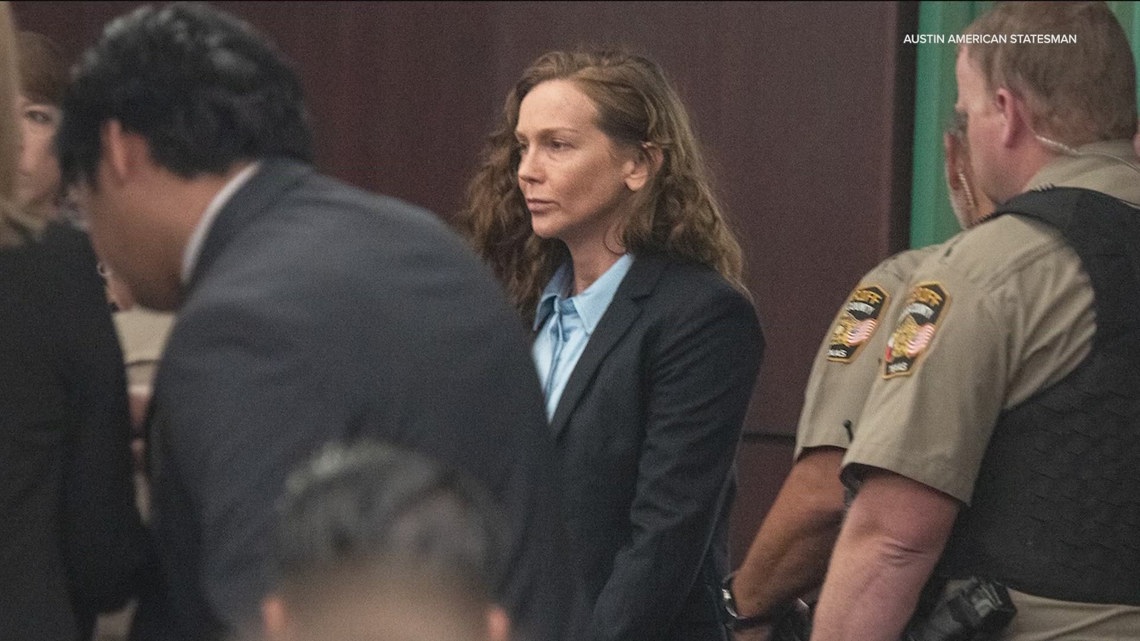Kaitlin Armstrong trial: Jury finds Armstrong guilty of murder

Both sides wrapped up their closing arguments on Thursday.
AUSTIN, Texas —
On Wednesday, the state rested its case and the defense questioned a police officer and several expert witnesses. Defense attorneys also brought Colin Strickland, Armstrong’s on again, off again boyfriend, back to the stand. Armstrong herself decided not to testify.
As in all cases, the state has the burden of proof. They must prove to the jurors that Armstrong killed Wilson beyond a reasonable doubt.
Prosecutor Ricky Jones makes closing arguments for state
The prosecution began its closing arguments visually. Attorneys played a video of Armstrong shooting a gun at a gun range, then played video from outside Wilson’s home on the night of her murder. In the video, Wilson can be heard screaming before two gunshots.
The state also showed an autopsy photo of the gunshot wound on Wilson’s chest. Attorney Rick Jones wrote on the slideshow, “There was silence and no more screams, then Armstrong put another bullet right in Wilson’s heart.”
“I’ve never seen so much evidence in my life against one person,” Jones told the jurors.
Jones noted that the defense asked why every other gun in the world was not excluded. The prosecution’s slideshow stated that no one else in the world with a Sig Sauger P365 left their DNA at the scene, no one else in the world was angry and jealous about their boyfriend being with Moriah Wilson, no one else in the world had their Jeep circling the location of the murder and no one else in the world left the scene of the murder in Armstrong’s Jeep two minutes after the crime was committed.
Jones said the defense argues that it could have been any black Jeep that was in the area on the night of the murder.
“However, her Jeep is traveling with her phone while sending personal texts. Proving that Kaitlin is in the Jeep, and Colin testified that she ultimately dries up to the house while Colin is in the garage,” Jones said.
Jones said it isn’t possible that someone else had Armstrong’s phone. He said the texts that were sent from her phone provided her home address, and there were also texts to Stickland about the real estate lawsuit the two were involved in at the time.
Jones showed a full-screen photo of Wilson on her bike, saying she was a 25-year-old prodigy who was taken away from her parents. He said Caitlin Cash, Wilson’s friend who found her body, doesn’t even like to go by her own name anymore. Jones said Cash said, “Kaitlin killed my friend.”
Jones also talked about Armstrong fleeing the country after Wilson’s death, saying, “She was on the beach, teaching yoga, while the Wilsons were trying to pick up the pieces.”
Jones wrapped up his closing arguments by saying, “Don’t do me a favor, do Mo Wilson a favor … Justice for Mo Wilson … Don’t let her [Armstrong] run like she tried to do 19 days before the trial.”
Defense begins closing arguments
Just before 11:30 a.m. Thursday, the defense began delivering its closing arguments.
Defense attorney Rick Cofer began in a quiet voice, saying that it has been one year, four months and 12 days that Armstrong has asserted her innocence. Cofer said this is a case based on assumptions, confirmation bias and a lack of direct evidence.
He said Strickland fostered insecurity and was not honest with Armstrong about his “special friend.” He said Strickland testified that Armstrong was not a particularly jealous girlfriend.
“Who brought up jealousy first? The Austin Police Department, Det. Richard Spitler. He first said that ‘j’ word because it was a great theory,” Cofer said.
He said the problem in Armstrong and Stickland’s relationship was not Wilson – it was always Strickland. Cofer also brought up the fact that Strickland changed Wilson’s name in his phone and deleted his text exchange with her on May 11.
“What was different on May 11?” Cofer asked.
Cofer said the PowerPoint prosecutors showed during their closing arguments hid what is essential. He said the jury should look at the raw data.
“The problem isn’t the data,” Cofer said. “It’s the presentation of the data.”
Cofer also brought up the fact that the first time Strickland testified, he said he thought maybe Armstrong was the one to get out of the black Jeep when it pulled up to his home on May 11. But when Strickland testified again on Wednesday, his recollection was clear – Cofer said the one fact Strickland was able to remember was that Armstrong was the one to get out of the Jeep. Cofer said it’s the one fact that drew attention away from Strickland and back to Armstrong.
Cofer demonstrated how to hold a bike from the center and said that area was not swabbed for DNA. He also brought up the fact that no DNA swabs were taken from inside Armstrong’s Jeep.
He addressed the unknown DNA on Wilson’s bike, gun and the rape kit that wasn’t tested, saying that APD didn’t want a single piece of evidence in front of the jury that might point away from Armstrong.
Cofer also addressed Armstrong going to Costa Rica. He brought up the possibility that she could have been concerned her “boyfriend,” Strickland, had killed Wilson or that the person who killed Wilson could kill her next. He said with fear, people act in fight or flight, and she chose flight.
Cofer said the argument the state is making is a “beautifully simple story, but it’s wrong.”
He also brought up the fact that Strickland’s laptop was the only piece of evidence to be removed from this case.
“What a world to be treated like Colin Strickland has,” Cofer said.
Cofer said APD thinks Armstrong killed Wilson because she fits the story they have created of a jealous lover. He said that story is so easy to tell because it ties into a framework of patriarchy and misogyny in America.
“If Kaitlin Armstrong didn’t kill Wilson, who did? I don’t know,” Cofer told the jury, adding that people want answers not a mystery. He said that answer is so unsatisfying because humans demand closure.
Cofer brought up more of Strickland’s testimony, where he said he thought of Armstrong as a mild and gentle person who is not particularly needy and said that he couldn’t imagine her hurting anyone.
He asked the jury to start thinking about the unknowns.
“That’s the whole point of the trial: the ‘I don’t knows’ are important,” he said. “It’s easy to swipe them off the table and accept Det. Spitler’s narrative, but jury duty is not supposed to be easy.”
He also brought up the ballistic evidence and said it’s not scientifically defensible. He compared it to DNA, saying both pieces of evidence how Armstrong as a possibility but not a definite match.
Cofer wrapped up his portion of the closing arguments by saying if the jury convicts Armstrong and then she’s exonerated, it will be because of untested DNA. The state objected to that statement, and defense attorney Geoffrey Puryear took over for the defense.
Puryear questioned how much trust Armstrong would have in the professionalism of APD after May 12, the day she was brought in on a theft of service charge, then told she could go because APD made a mistake, then told she should stay to talk because Strickland brought up her name.
“Det. Spitler had tunnel vision and jumped to conclusions,” Puryear said.
State attorney Guillermo Gonzales leads rebuttal
Gonzales started each sentence with “but Rick…,” following a tactic Rick Cofer used in his argument to bring up questions the jury might have about the case.
“Rick, you seem to be blaming it on Colin Strickland, but you say you don’t know who did it. Why can’t you stick to one reasonable explanation of what happened?” Gonzales said.
He then addressed the jury, saying, “Be reasonable. Use your common sense and look at the evidence.”
Gonzales said all the evidence points to Strickland being in South Austin at the time of Wilson’s murder, which explains why his devices – including his laptop – weren’t investigated further. Gonzales said the defense is trying to distract the jury by focusing on Strickland’s laptop.
He brought up the DNA evidence and how Dr. Tim Kalafut testified that if it wasn’t direct DNA from Armstrong on Wilson’s bike, it would have had to have been transferred four times, which Kalafut said was highly unlikely.
Gonzales said the most reasonable explanation for Armstrong’s DNA to be on Wilson’s bike is that she picked it up by the handlebars and seat and threw it.
“Every time you turn around, it’s pointing at her [Armstrong],” Gonzales said.
Gonzales then spoke about how the medical examiner explained that Wilson sustained two shots to the head and another to the heart while she was lying on the floor.
Gonzales asked why Armstrong would use fake names in Costa Rica and why she would desperately search for plastic surgery. He said it was because she was a fugitive trying to get away with a crime.
Gonzales closed by saying, “Keep your eye on the ball, that’s all I’m asking … Let the evidence take you where it’s going” before pointing directly at Armstrong and saying, “That’s the evidence right here, beyond a reasonable doubt.”
Closing arguments wrapped at around 12:15 p.m., and the jury went straight into deliberations.
If the jury finds Armstrong guilty, she could face up to 99 years in prison. The prosecution is not pursuing the death penalty.
https://www.wfaa.com/article/news/crime/kaitin-armstrong-trial-closing-arguments/269-7d7750ae-13e7-477e-a740-8ee80c09c796 Kaitlin Armstrong trial: Jury finds Armstrong guilty of murder


